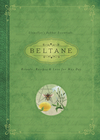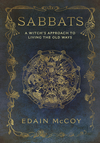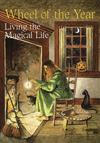May Day Traditions, Old & New

Raven Grimassi's Beltane, the third in Lllewellyn's series on the Wiccan sabbats, examines the ancient Pagan origins of May Day festivals that thrived up to the end of the nineteenth century. Explore the evolution of the Maypole and various folklore characters connected to May Day celebrations. Discover the influences of ancient Greek and Roman religions on May themes arising in the Celtic cultures of continental Europe and the British Isles.
This well-researched book corrects many of the common misconceptions associated with May Day. It reveals the spirituality and connection to Nature than are intimate elements of May Day celebrations.
Beltane includes arts and crafts projects, recipes for celebratory meals, and several spells related to the May themes of growth and gain. In the following excerpts, Grimassi describes how to construct a miniature Maypole to adorn your home or altar, and how to summon up a delicious May Serpent Cake!
Maypole Centerpiece
Items needed:
- 18" wood dowel or thin branch
- 6–9" diameter flat round plaque
- One small grapevine wreath approximately 6–8" in diameter, decorated on both sides
- One yard each of red and white ribbon
- Scissors
- Drill and 1/4" drill bit
- One 11/4" length flat-head wood screw (adjust length to thickness of wood plaque as screw will need to extend through the plaque to secure the dowel on the other side)
- Hot glue gun and glue stick
Instructions:
- Drill hole through bottom of center of plaque and drill a hole 1/2" deep into the bottom of the dowel.
- Glue ribbons crossed on top of dowel.
- Attach dowel to stand by screwing the screw through the plaque, and then screw dowel onto the screw.
- Glue wreath on top of the dowel by melting a medium dab of glue on top of the crossed ribbons and to the bottom of the wreath, then join the wreath to the top of the dowel. To make more secure, wait a few minutes and then glue around the edge of the wreath where it meets the dowel, filling in gaps.
- Braid the ribbons—one color going left and under the other color, which is moving right. Braid about 2" down dowel and tack to dowel with hot glue gun to keep in place. When set, tack the ends of the ribbons to the edge of the wood plaque with hot glue.
- You can also add a small figurine, bird figure, or other symbolic items in the opening of the wreath.
May Serpent Cake
Ingredients (makes 2 cakes):
- 3/4 cup of sugar
- 1/2 teaspoon of ground cloves
- 11/2 teaspoons ground nutmeg
- Grated zest of one orange
- 1 teaspoon salt
- 4 1/2 cups plus 2 tablespoons unbleached all-purpose flour
- 1/2 cup unsalted butter
- 3/4 cup plus 3 tablespoons honey, boiling
- 1/2 cup strong brewed espresso coffee
- 1 egg
- 1/3 cup amaretto or rum
- 1/3 cup jam, wild cherry or raspberry
- Coffee beans and candied orange peel for garnish
- 1 teaspoon baking soda
Mix the sugar, spices, orange zest, baking soda, and salt into the flour. Cut in the butter with a pastry blender until it is the size of small pebbles. Pour in the boiling honey, coffee, and liqueur and mix until smooth. Let cool and then turn out onto a floured surface.
Divide the dough in half. Roll the first half into an 18-inch long cylinder. Make a deep trough down the center and carefully place it, seam side down, on a baking sheet lined with parchment paper. Be sure that the smooth side is up. Bend the dough carefully into a circle and fashion the snake's head at one end, making a triangle shape. Taper the other end to make the tail. Firmly set two coffee beans for the snake's eyes. Bake the cakes at 400 degrees for about thirty minutes.

About Raven Grimassi
Related Products



is subject to certain Terms and Conditions